Chapter 17- Changes in Communities
1/92
There's no tags or description
Looks like no tags are added yet.
Name | Mastery | Learn | Test | Matching | Spaced |
|---|
No study sessions yet.
93 Terms
Communities are…
always changing, some more than others
Agents of change act on communities across all
temporal and spatial scales
Stress
factors that reduce growth, reproduction, or survival of individuals
Disturbance
Abiotic events that injure or kill some individuals and create opportunities for other individuals
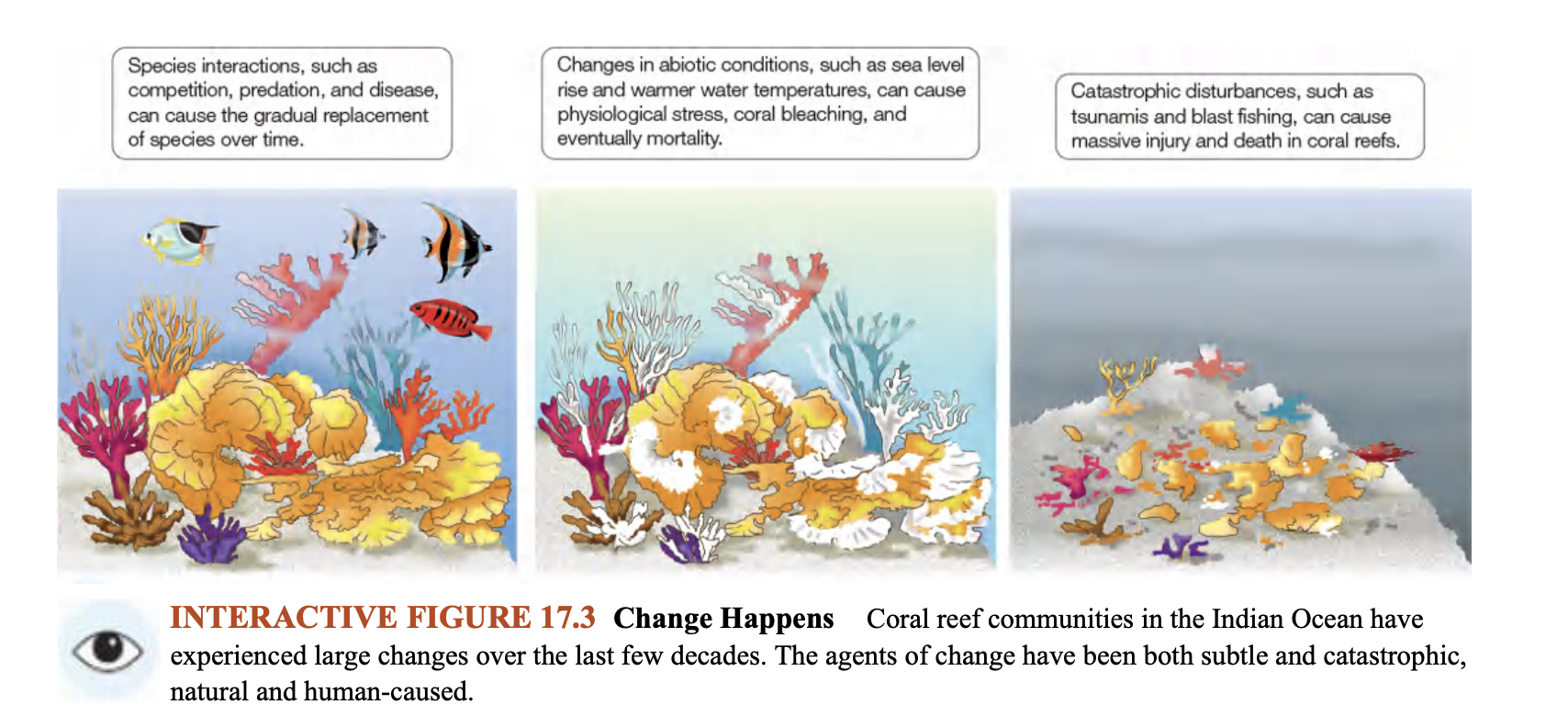
What could be subtle agents of change on a reef (causing stress)?
Fig 17.3- Change Happens
The slow rise to dominance of certain coral species, and the slow decline of others, due to the effects of competition, predation, and disease.
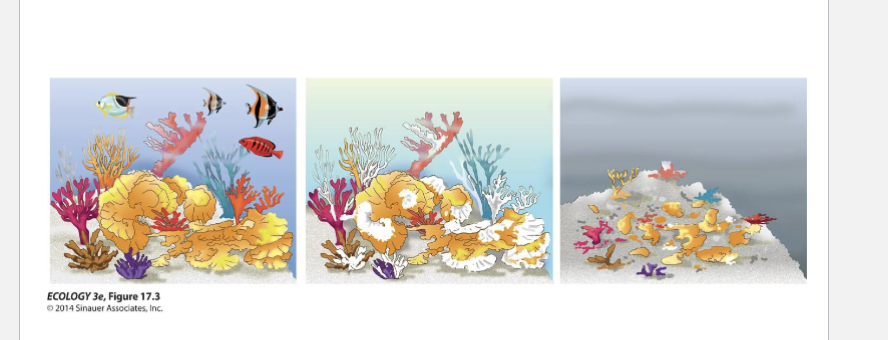
What could be more serious/ catastrophic agents of change (a disturbance)
Fig 17.3- Change Happens
massive deaths of corals in the last decade due to bleaching (loss of symbiotic algae)
The great tsunami of 2004, resulting in the replacement of some coral species with other species, or no replacement at all.
Examples of Abiotic Agents of Stress, Disturbance, and Change in Communities
Waves, Currents, Winds, water supply, chemical composition, temperature, volcanic activity,
Examples of Biotic Agents of Stress, Disturbance, and Change in Communities
Negative interactions
Competition
Predation
Herbivory
Disease
Parasitism
Trampling
Digging
Boring
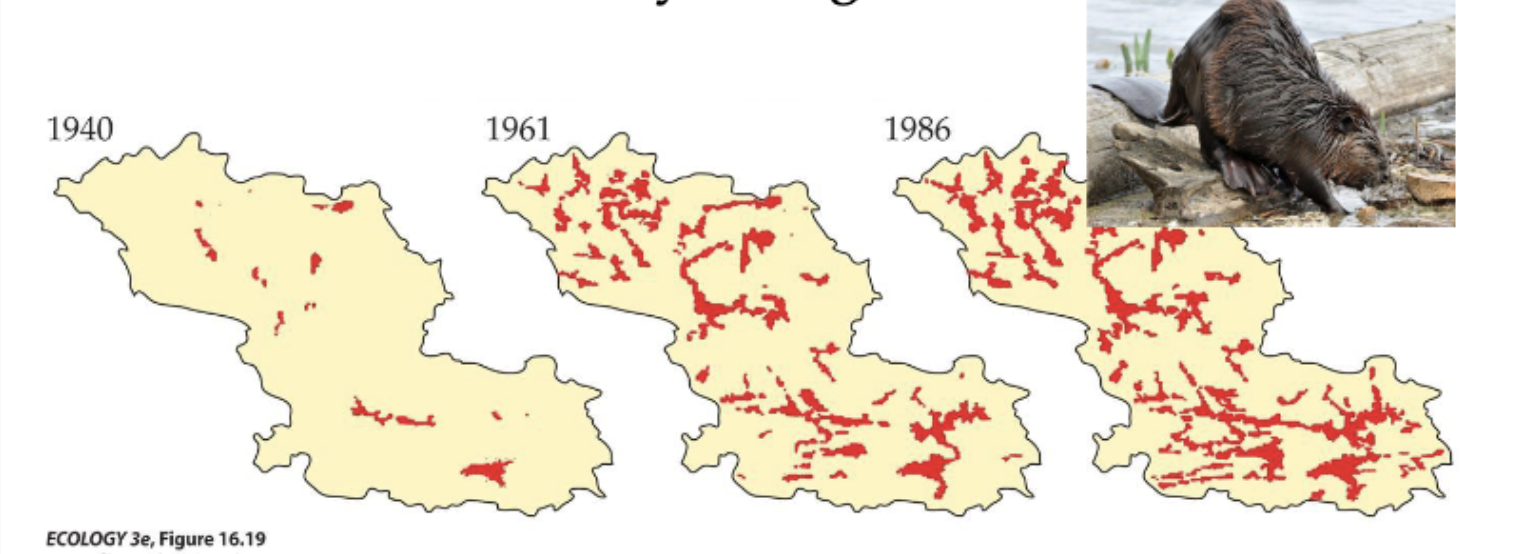
What can Biotic interactions result in with another species?
Replacement of one species with another
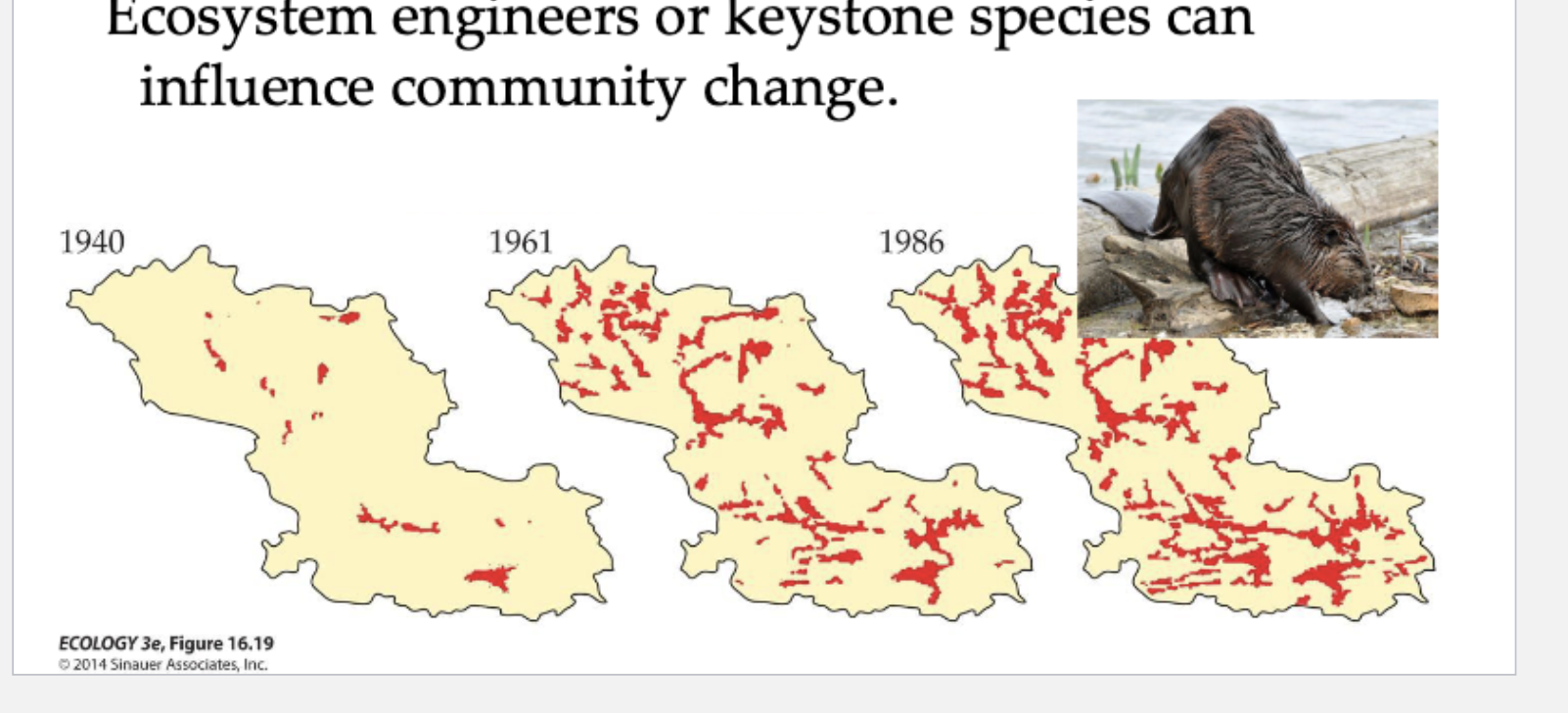
How can disease initiate community changes
By causing death or slow growth of a species
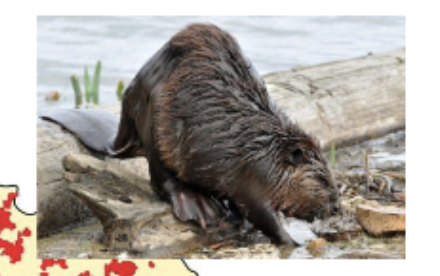
Importance of Engineer or Keystone species
They can influence community change
Importance of smaller and more frequent disturbances
It can open patches of resources for other individuals
Succession
is change in the species composition of communities over time
What causes succession?
A variety of abiotic (physical and chemical) and biotic agents of change
Two types of succession
Primary
Secondary
Primary Succession Definition
Colonization of habitats devoid of life as a result of catastrophic disturbance or because they are newly created habitats (e.g. volcanic rock)
Secondary Succession
Reestablishment of a community in which some, but not all, organisms have been destroyed
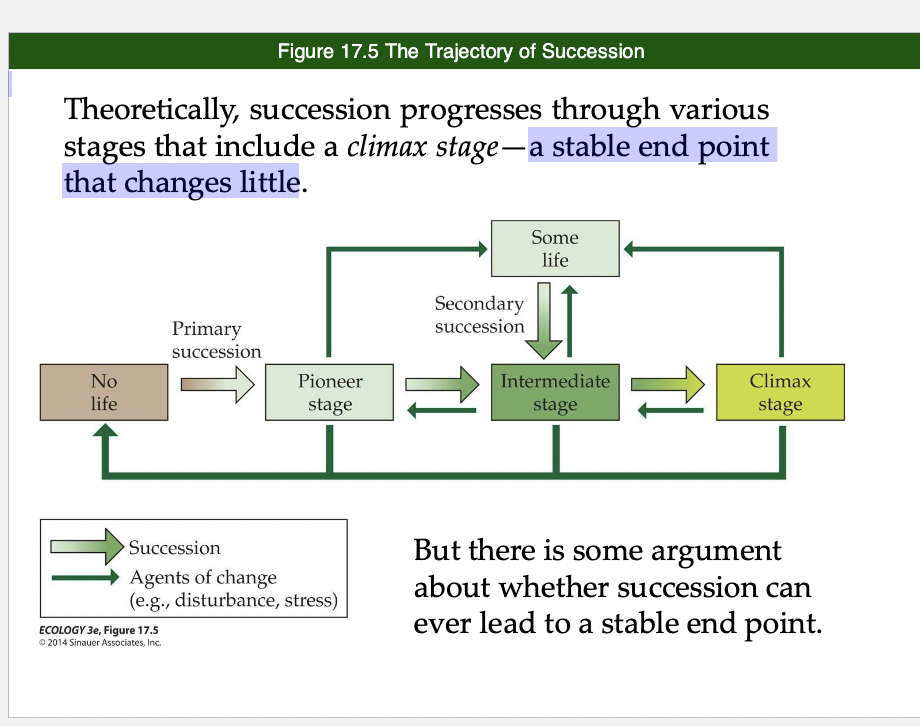
Climax stage
a stable end point that changes little
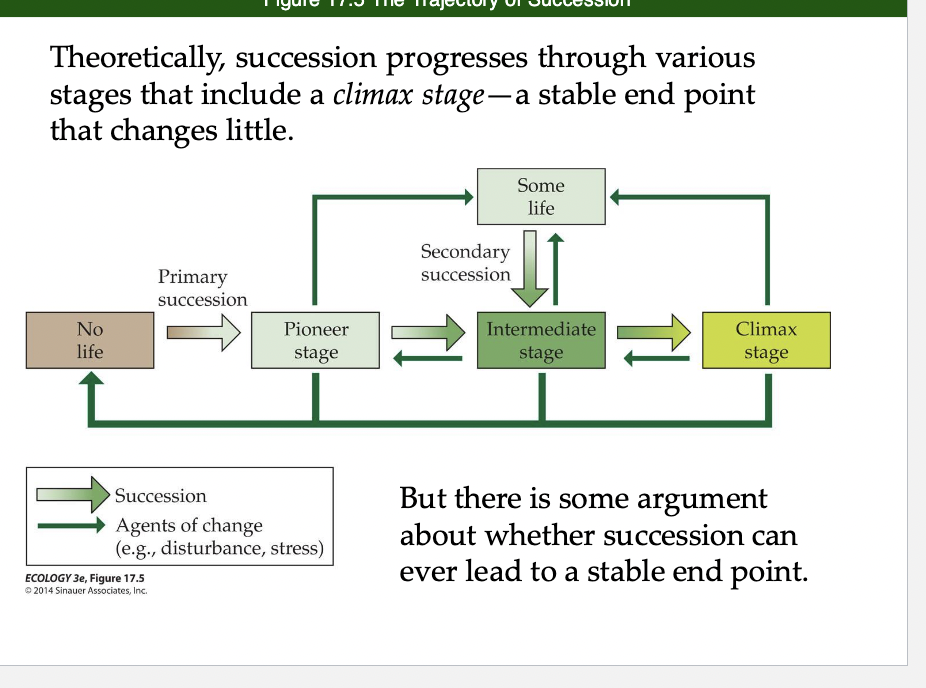
Components of Primary Succession
No life to Pioneer Stage
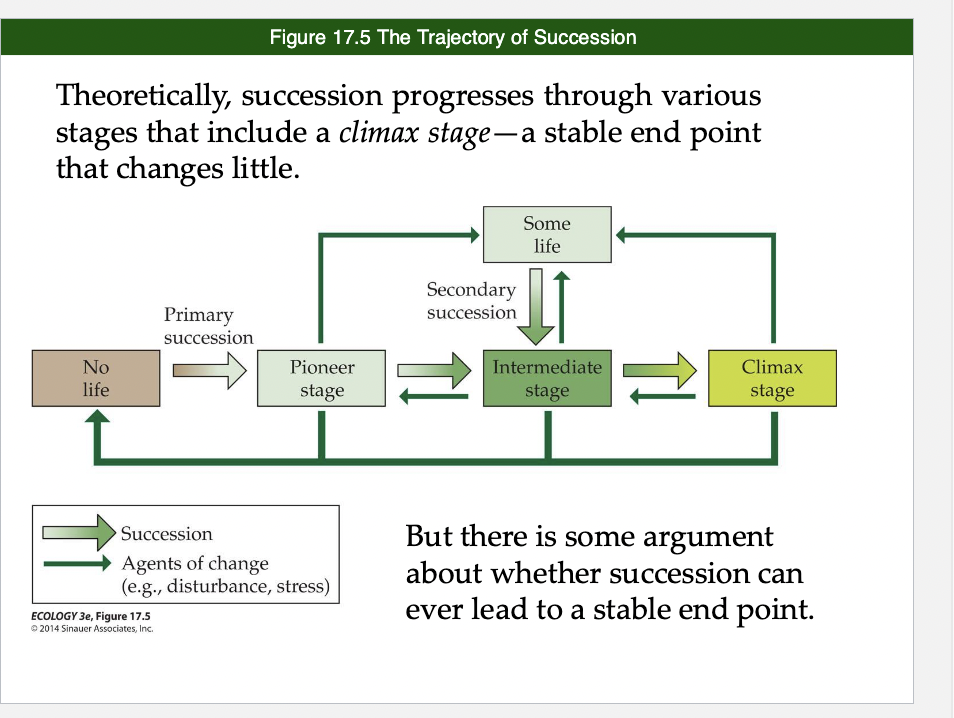
Components of Secondary Succession
Some life to Intermediate Stage
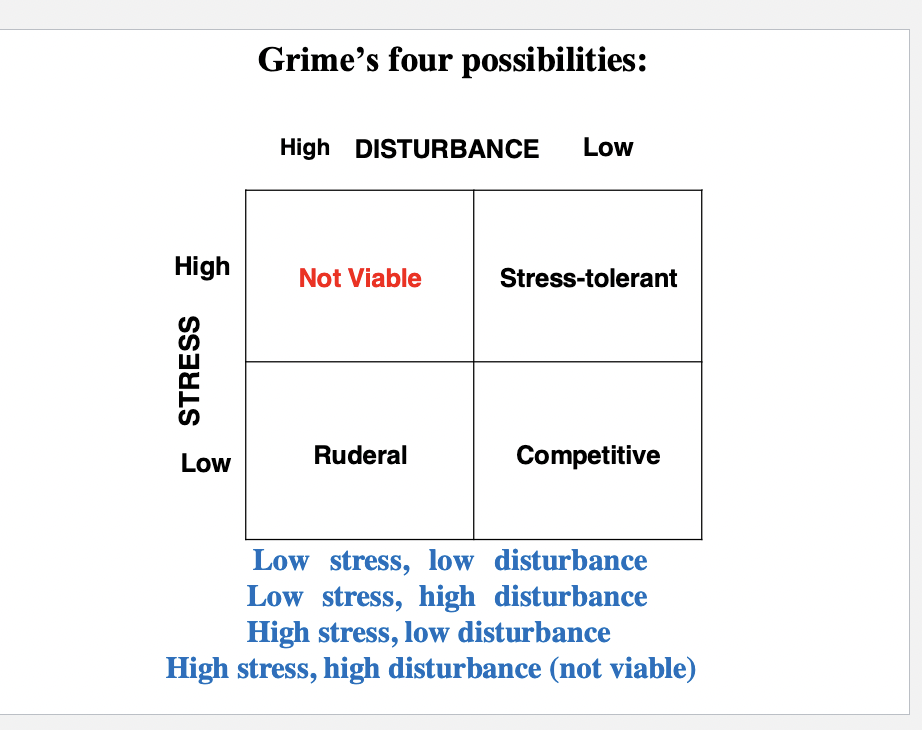
Grimes 4 possibilites
Low stress, low disturbance
Low stress, high disturbance
High stress, low disturbance
High stress, high disturbance
Outcome of Low stress, low disturbance
Competitive
Outcome of Low stress, high disturbance
Ruderal (A plant that is associated with human dwellings or agriculture, or one that colonizes waste ground)
Outcome of high stress, low disturbance
Stress-tolerant
Outcome of high stress, high disturbance
Not Viable
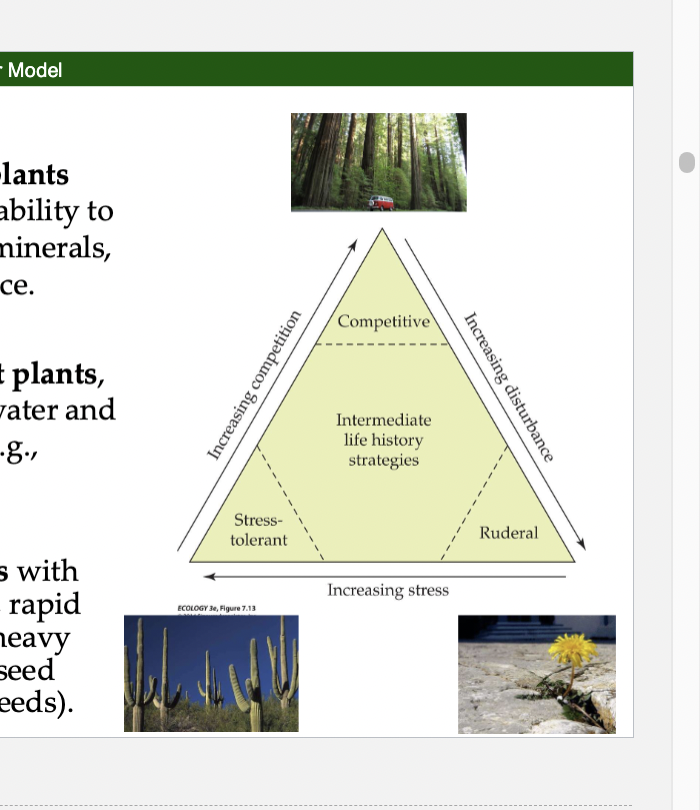
Competitive plants
With superior ability to acquire light, minerals, water, and space
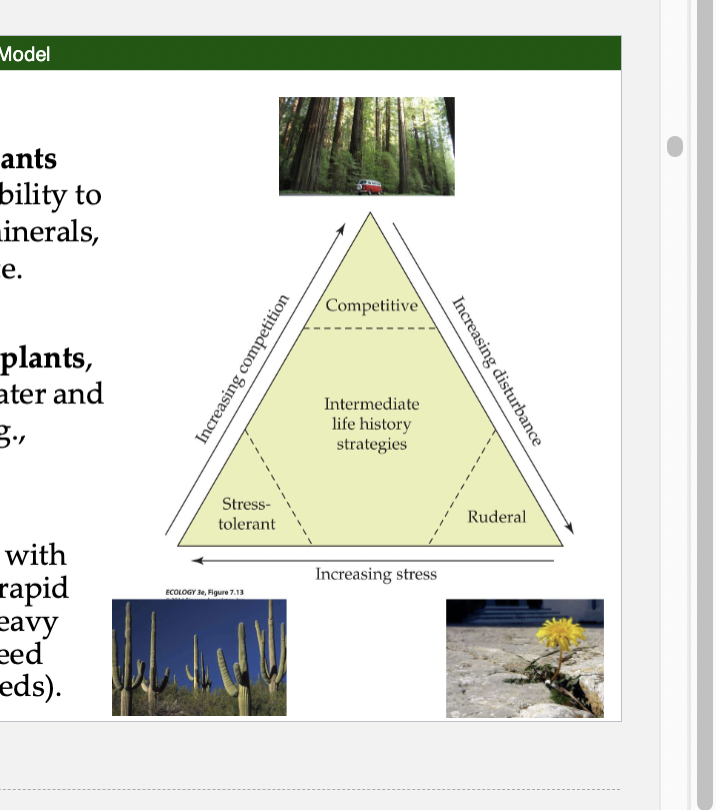
Stress- Tolerant Plants
Slow rates of water and nutrient use (e.g., succulents)
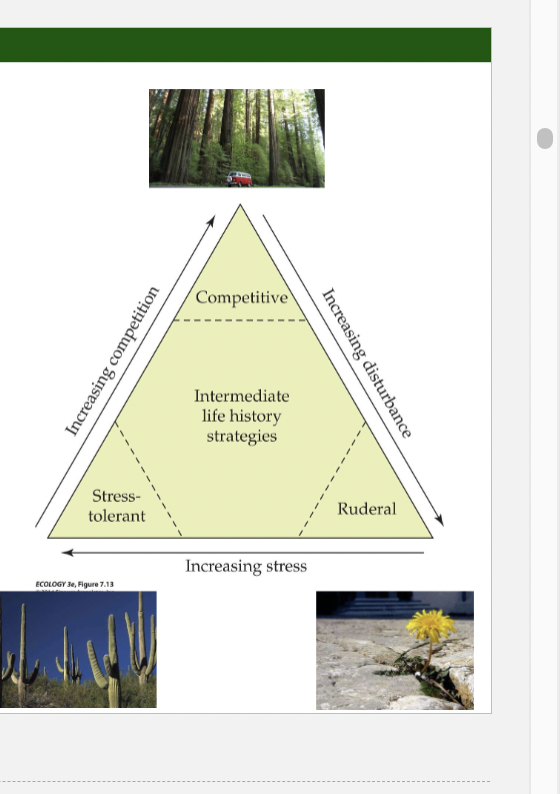
Ruderal Plants
With short life span, rapid growth rates, heavy investment in seed production (weeds)
Selections that describe two ends of a reproductive strategy continuum
r-selected
K-selected
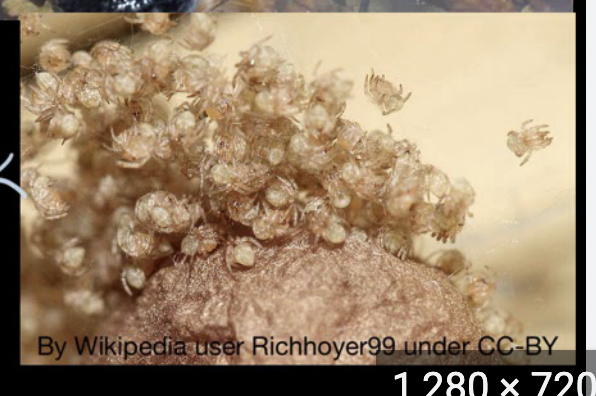
Compoents of r-selected species
Short-lived
High Mortality
Fast growing
Early maturation
High reproductive rates
Viable/ Stressful environments
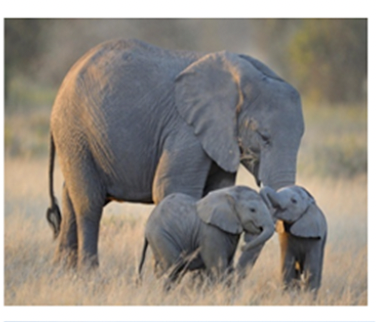
Components of K-selected species
Long-lived
Low mortality
Slow growing
Late maturing
Low reproductive rates
Stable environments
Environments for r-selected species
Variable/ stressful environments
Environments for K-selected species
Stable environments
Basics of Primary Succession
Can be very slow
Initial conditions can be very inhospitable
First colonizers (Pioneer or Early successional species) tend to be stress-tolerant
Transform the habitat in ways that benefit their growth and that of other species
First colonizers (pioneer or early successional species) tend to be…
Stress- tolerant
Basics of Secondary Succession
Occurs after primary succession
Or can occur after fires, storms, logging, disturbance to climax community
The legacy of preexisting species and their interactions with colonizing species play larger roles than in primary succession
Preexisting species secondary succession vs primary succession
Preexisting species and their interactions with colonizing species play larger roles in secondary than in primary succession
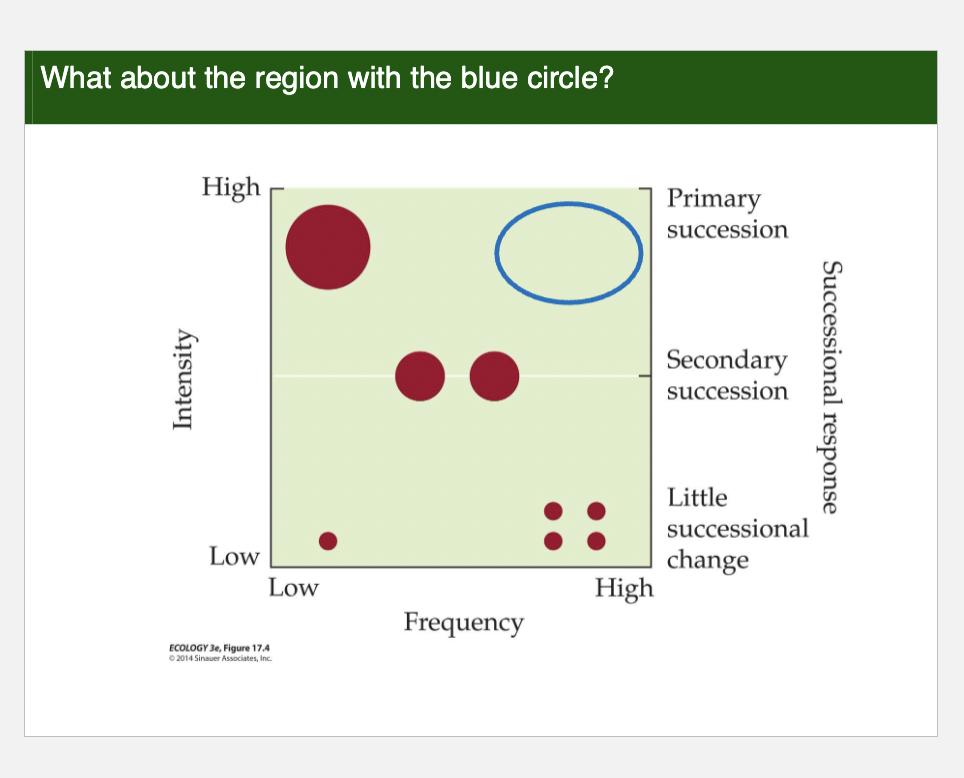
Explain this Graph of Disturbance Intensity vs Disturbance Frequency and the Type of Ecological Succession that occurs
Little successional Changes Occurs When:
When disturbance is frequent and mild — communities don’t have time or need to change much
Blue Region
High disturbance intensity
High disturbance frequency
The region with the blue circle represents areas of very frequent and intense disturbance, where succession is often suppressed or reset constantly, leading to little successional change. Stable communities cannot form, and primary succession is unlikely due to the lack of recovery time
Succession can take decades to centuries, so how can we “observe” succession without watching the entire process unfold?
Henry Cowles assumed that plant assemblages farthest from the lake’s edge were the oldest; the ones nearest the lake were the youngest, representing a time series of successional stages.
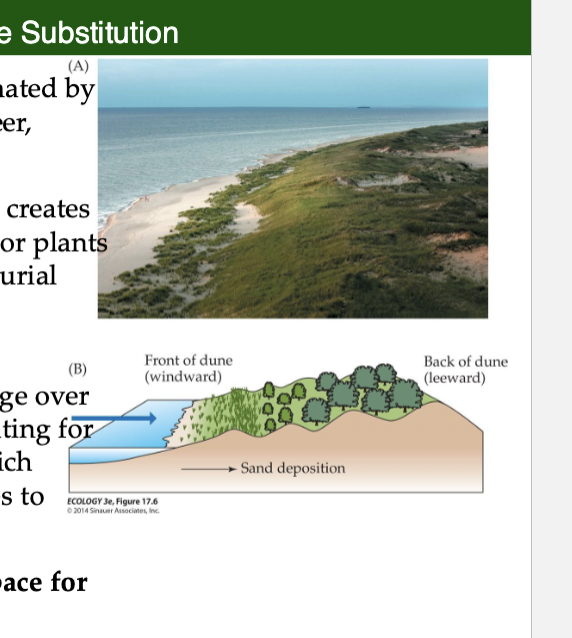
Figure 17.6- Henry Cowles’ experiment and Outcomes
The first stages were dominated by a hardy ecosystem engineer, American beach grass.
Beach grass traps sand and creates hills that provide refuge for plants less tolerant of constant burial and scouring.
Cowles could predict how communities would change over time without actually waiting for the pattern to unfold, which would have taken decades to centuries.
This technique is called “space for time substitution.”
Studied dunes of different distances from the lake shore.
Assumed that further inland = older dunes, and closer to shore = newer dunes
SPACE FOR TIME SUBSTITUTION
Space for Time Substitution
Assumes time is the main factor causing communities to change
Assumes unique conditions in a location are inconsequential
Charles Elton Experiment for Succession and Outcomes
Believed that organisms and the environment interact to shape succession.
Succession in English pine forests following felling depended on moisture conditions.
Wet areas developed into sphagnum bogs, drier areas developed into grass and sedge marshes.
Elton emphasized that the only way to predict the trajectory of succession was to understand the biological and environmental contex in which it occurred. In other words, time is not the only player in succession
Elton also recognized the contribution of animals to succession
CC Clements, Gleason, and Charles Elton’s approaches to succession that helped Henry Cowles’ Space for Time Substitution experiment
Aspect | Frederic Clements | Henry Gleason | Charles Elton |
|---|---|---|---|
View of Community | A superorganism – tightly integrated and structured | A coincidental collection of species with similar needs | A dynamic system shaped by both species and environment |
Succession Pattern | Orderly and predictable (like an organism’s life cycle) | Unpredictable and variable, shaped by chance and dispersal | Context-dependent; affected by environmental conditions and species traits |
End Point (Climax) | Yes – a stable climax community determined by environment | No fixed climax – multiple possible endpoints | No single climax – trajectory depends on conditions |
Role of Species | Species are interdependent; cooperation dominates | Species are independent; individual responses dominate | Species interact with and respond to the environment |
Role of Environment | Drives a fixed successional path | Sets the stage, but outcomes are not fixed | Environmental variation affects which path succession takes |
Mechanism of Change | Facilitation – early species prepare habitat for later ones | Dispersal & tolerance – species arrive and survive based on their traits | Species-environment interactions – both facilitation and inhibition occur |
Legacy | Inspired the facilitation model | Inspired the tolerance and inhibition models | Highlighted the importance of external context in shaping succession (e.g., deforestation example) |
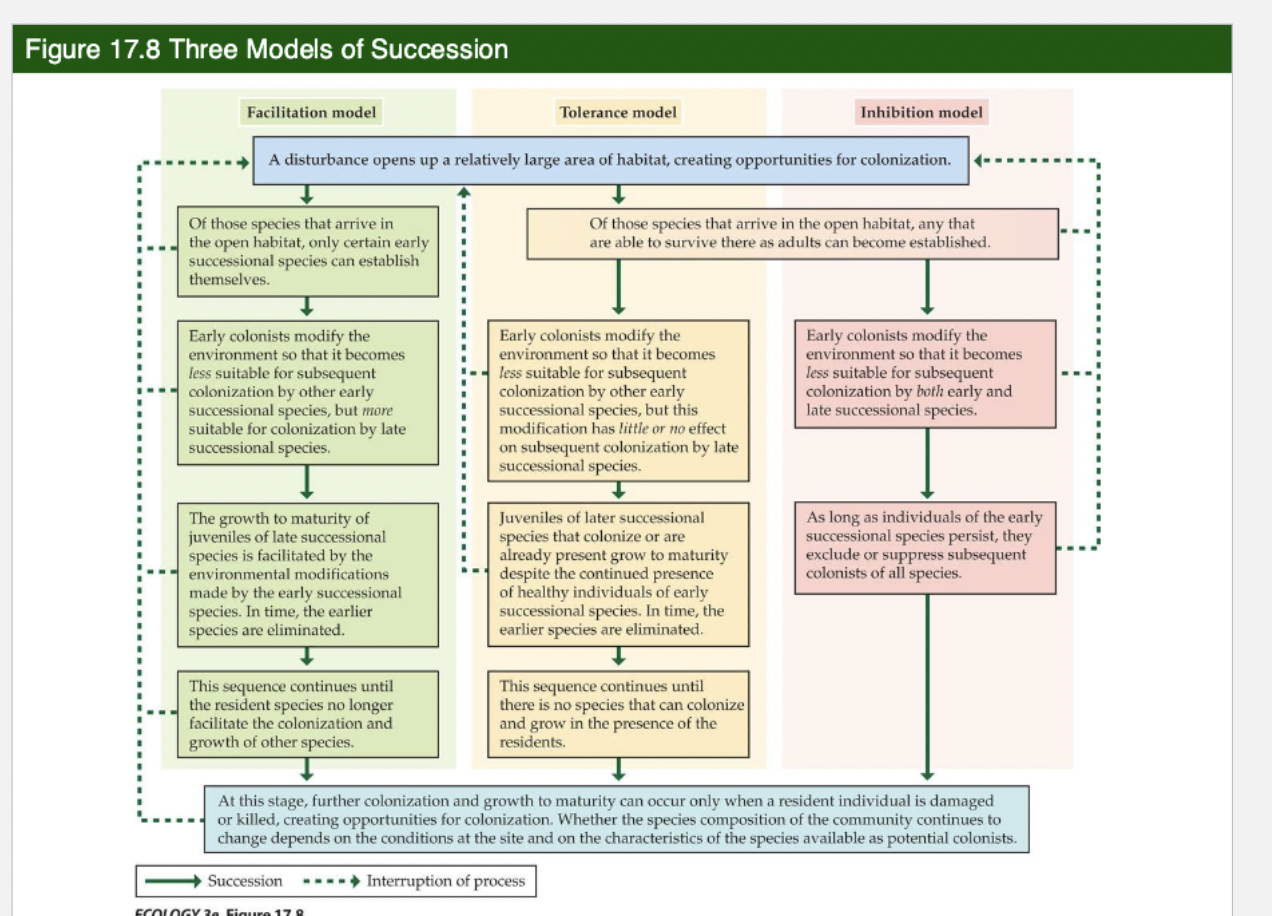
Three Models of Succession (Connell and Slatyer)
Facilitation Model
Tolerance Model
Inhibition Model
Facilitation Model
Inspired by Clements
Early species modify the environment in ways that benefit later-arriving species but hinder their own continued dominance
Facilitation Model early species
These early successional species have characteristics that make them good at colonizing open habitats, dealing with physical stress, growing quickly to maturity, and ameliorating the harsh physical conditions often characteristic of early successional stages.
Facilitation Model Later Species
Eventually, however, a sequence of species facilitations leads to a climax community composed of species that no longer facilitate other species and are displaced only by disturbances
Tolerance model
Earliest species modify the environment, but in neutral ways that neither benefit nor inhibit later species.
Tolerance Model Early Species
Grow and reproduce rapidly life strategy
Tolerance Model Later Species
Later species persist merely because they have life history strategies such as slow growth, few offspring, and long life that allow them to tolerate increasing environmental or biological stresses that would hinder early successional species.
Inhibition Model
Early species modify conditions in negative ways that hinder later successional species.
Inhibition Model Early Species
These early colonizers may monopolize resources needed by subsequent species.
This suppression of the next stage of succession is broken only when stress or disturbance decreases the abundance of the inhibitory species.
Inhibition Model Later Species
As in the tolerance model, later species persist merely because they have life history strategies that allow them to tolerate environmental or biological stresses that would otherwise hinder early successional species.
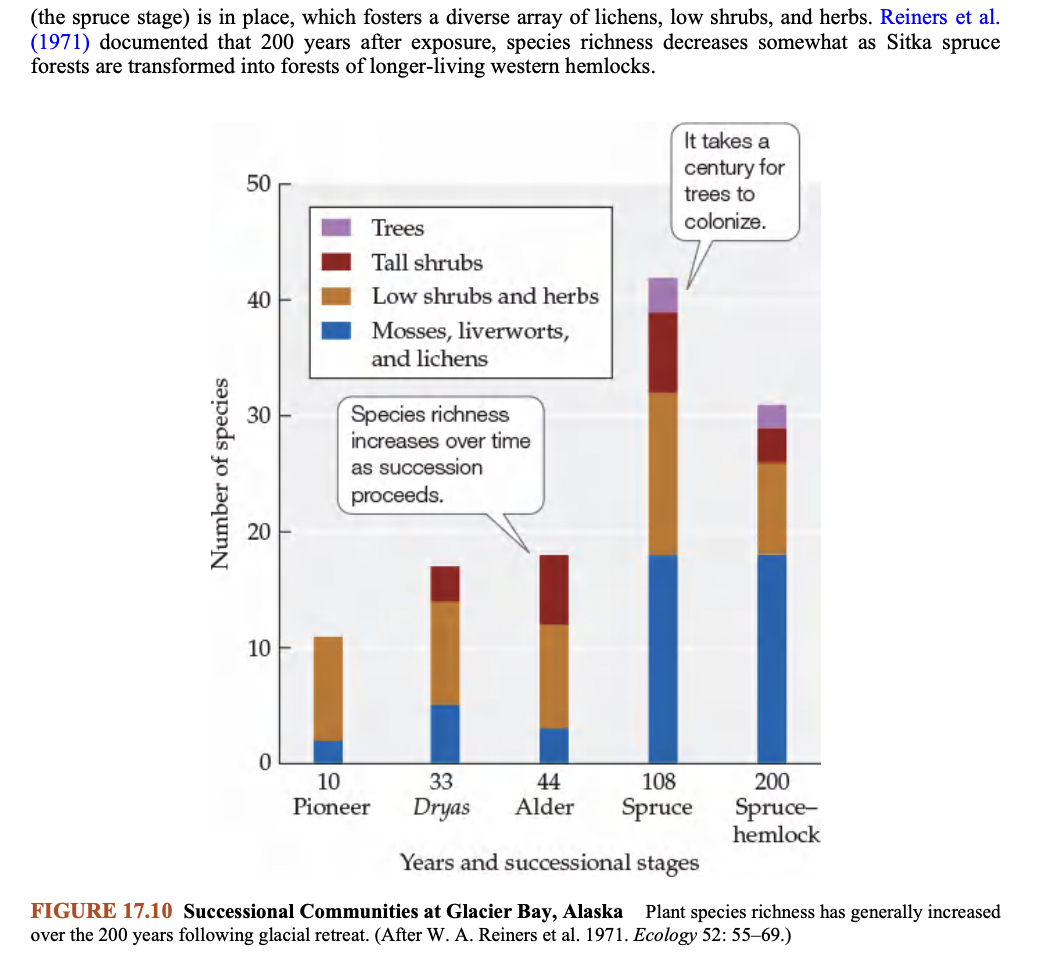
William Cooper Glacial Bay “Space for Time” Substitution Opportunity Experiment
He established permanent plots that are still being used today.
Glacier Bay, Alaska is one of the best-studied examples of succession.
Melting glaciers have led to a sequence of communities that reflect succession over many centuries.
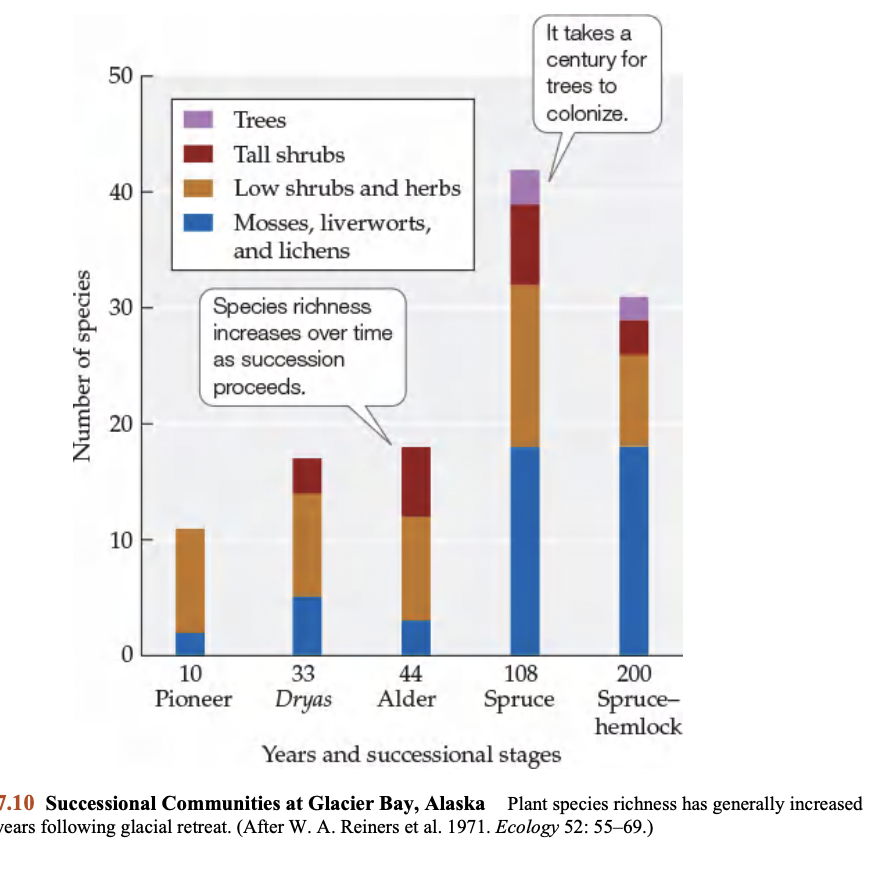
Fig 17.10- Results of Cooper’s Successional Communities at Glacier Bay, Alaska
This graph shows how primary succession is slow, with each stage building the foundation for the next.
Supported models of facilitation, inhibition, and tolerance, depending on the stage.
Tree colonization is delayed due to the need for developed soil and stable microclimates.
Pioneer Stage→ Facilitation
Dryas Stage→Inhibition & Facilitation
Alder Stage Facilitation → Inhibition
Spruce Stage → Tolerance
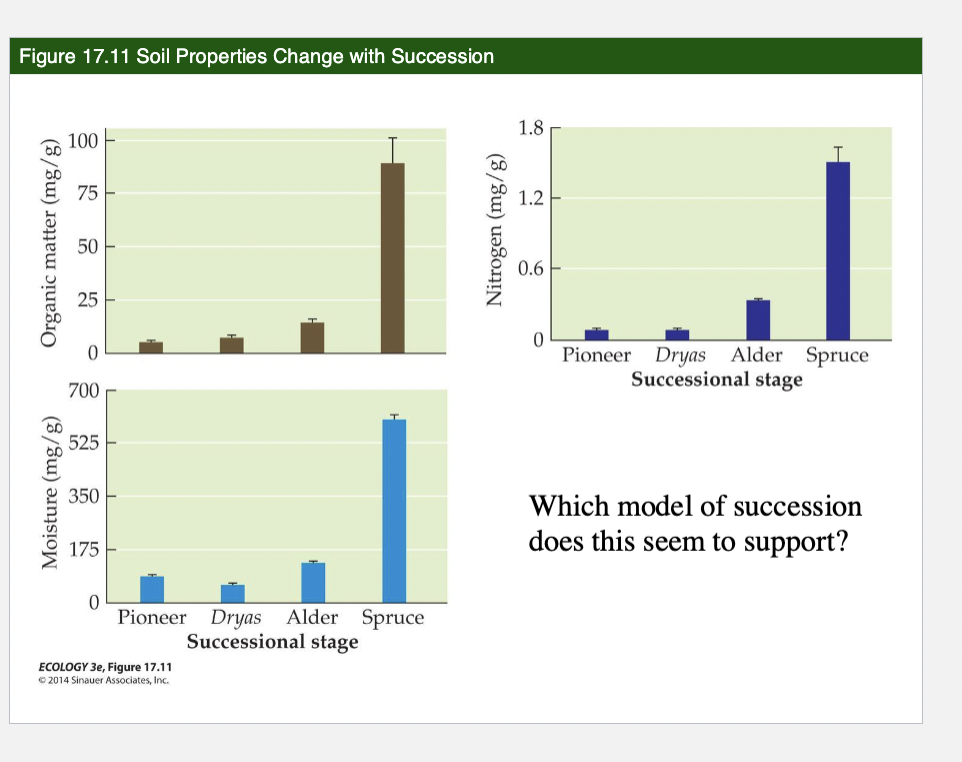
Fig 17.11- Chapin Experiment: Soil Properties Change with Succession: What model of succession do these models support
These patterns show that:
Early species modify the environment in ways that benefit later species.
The community becomes more nutrient-rich, moist, and organic over time.
These experiments, along with observations of unmanipulated plots, showed that neighboring plants had both facilitative and inhibitory effects on the spruce seedlings but that the directions and strengths of those effects varied with the stage of succession
➡ Facilitation Model
This model proposes that:
Early colonizers (like mosses, lichens, Dryas, and alder) alter the environment (e.g., fix nitrogen, add organic matter),
Making conditions more favorable for later successional species (like spruce),
Paving the way for increased species richness and complexity.
This is exactly what we see here: early stages enrich the soil, allowing trees to eventually colonize.
Chapin Experiment: Pioneer Successional Stage Positive and Negative Effects on Spruce
Positive:
Higher Survival
Negative:
Lower Germination
Dryas Successional Stage Positive and Negative Effects on Spruce
Positive:
Higher Nitrogen Level
Higher Growth
Negative:
Lower Germination
Lower Survival
Higher Seed Predation and Seed Mortality
Alder Successional Stage Positive and Negative Effects on Spruce
Positive:
Higher Soil organic matter
Higher Nitrogen Level
More mycorrhizae
Higher Growth
Negative:
Lower germination
Lower Survival
Higher Seed Predation and seed mortality
Root Competition
Competition for Light
Spruce Successional Stage Positive and Negative Effects on Spruce
Positive:
Higher germination
Negative:
Lower growth
Lower Survival
Higher Seed Predation and seed mortality
Root Competition
Competition for Light
Lower Nitrogen Level
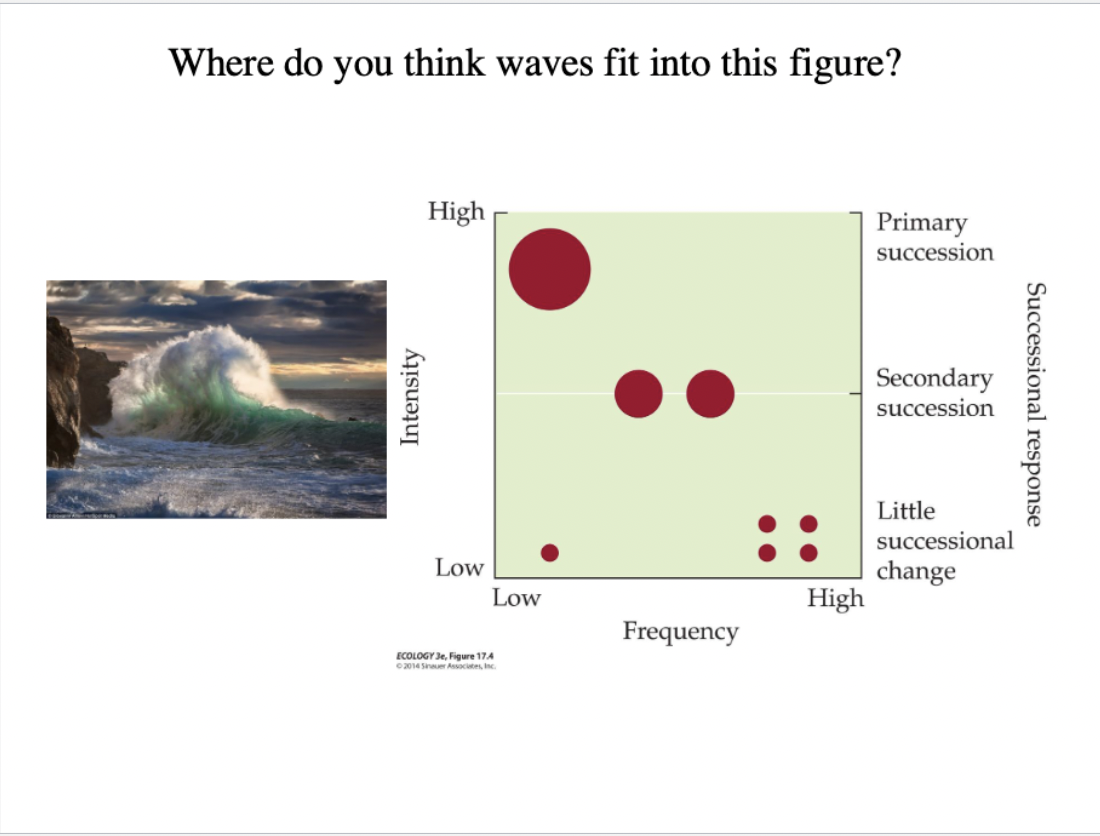
Where Do Waves Fit in the Figure?
Answer: Bottom right quadrant
High frequency (they occur often)
Low to moderate intensity (they generally don’t remove all biomass or reset the system)
This corresponds to an area of "little successional change" in the diagram.
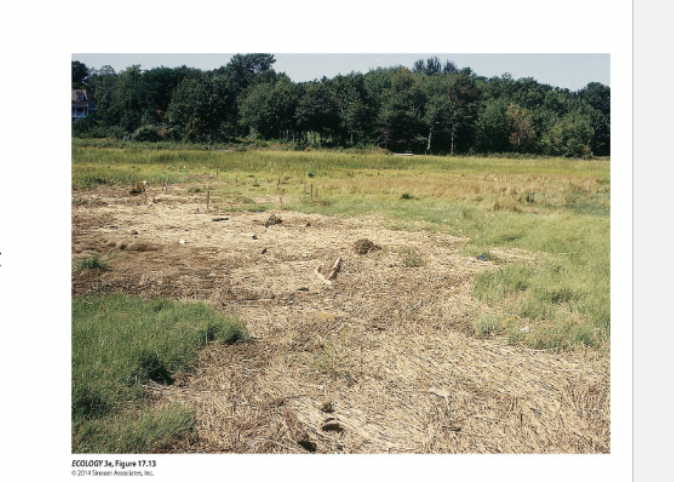
Figure 17.13 Wrack Creates Bare Patches in Salt Marshes
New England Salt Marsh: secondary succession.
Salt marshes have different species compositions and physical conditions at different tidal elevations.
Cordgrass, Spartina patens, dominates near the sea border; spike rush, Juncus gerardii, is found at the terrestrial border.
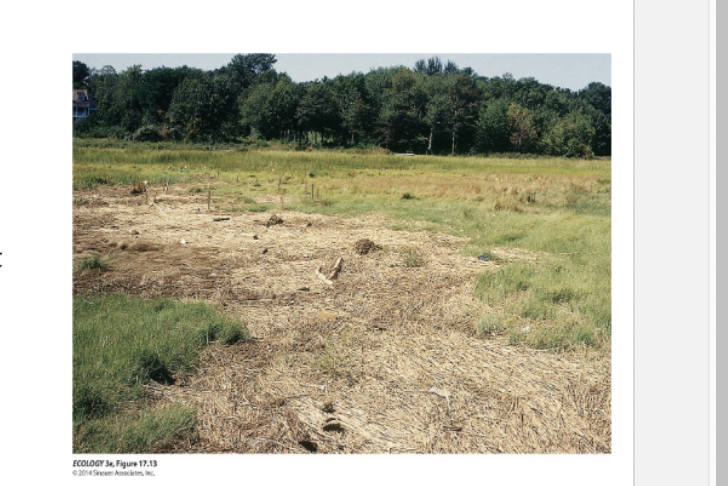
Figure 17.13- What is Wrack?
(dead plant material) smothers and kills plants, leaving patches where secondary succession occurs. Salinity in the bare patches is high because of evaporation
Bertness and Shumway Experiment
New England Salt Marsh
Hypothesized that Distichlis could either facilitate or inhibit later colonization by Spartina or Juncus depending on the salt stress experienced by the interacting plants.
Bertness and Shumway (1993) manipulated patches after they had been colonized to understand patterns of succession and the role Distichlis played
Spike grass, Distichlis spicata, colonizes the patches first. It is eventually outcompeted by both Spartina and Juncus in their respective zones.
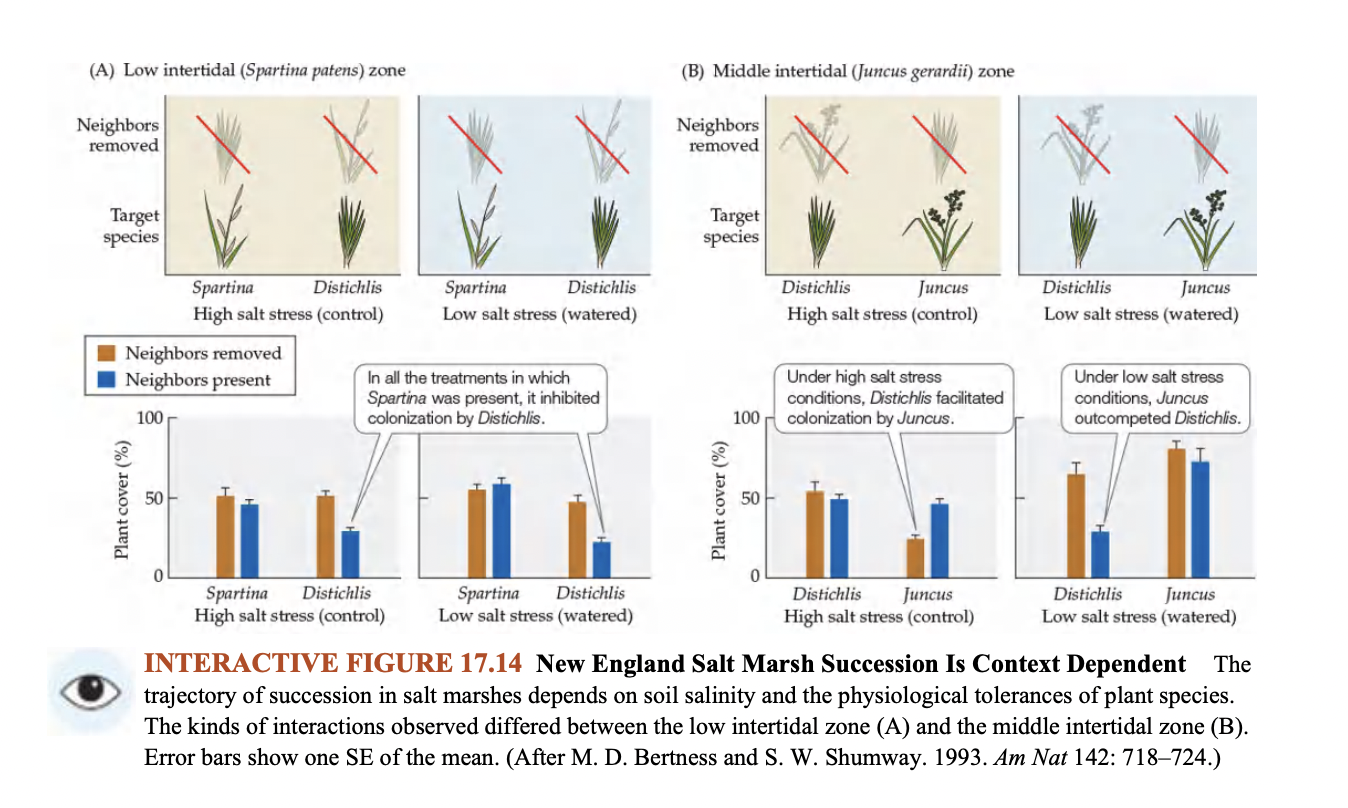
Figure 17.4: New England Salt Marsh Is Context Dependent: Experimental Observations
Experimental Design:
Two tidal zones were studied:
Low intertidal (Spartina zone) — closer to the shoreline
Middle intertidal (Juncus zone) — closer to land
In each zone, researchers created experimental bare patches and then:
Removed Distichlis from some patches and left Spartina or Juncus.
Removed Spartina or Juncus from other patches, leaving Distichlis.
Control patches were left unmanipulated to observe natural colonization.
Additionally, in each zone, half the patches were watered with fresh water to reduce salt stress, while the others were left dry.
In the Spartina zone (low intertidal)…
Spartina always colonized and dominated the plots, whether or not Distichlis was present or watering occurred.
Distichlis was able to dominate only if Spartina was removed, so it was clearly inhibited by Spartina (inhibition).
In the Juncus zone (middle intertidal)…
Juncus was able to colonize only if Distichlis was present or watering occurred.
The presence of Distichlis helped shade the soil surface, thus decreasing salt accumulation (facilitation).
If plots were watered…
Distichlis was easily outcompeted by Juncus (tolerance).
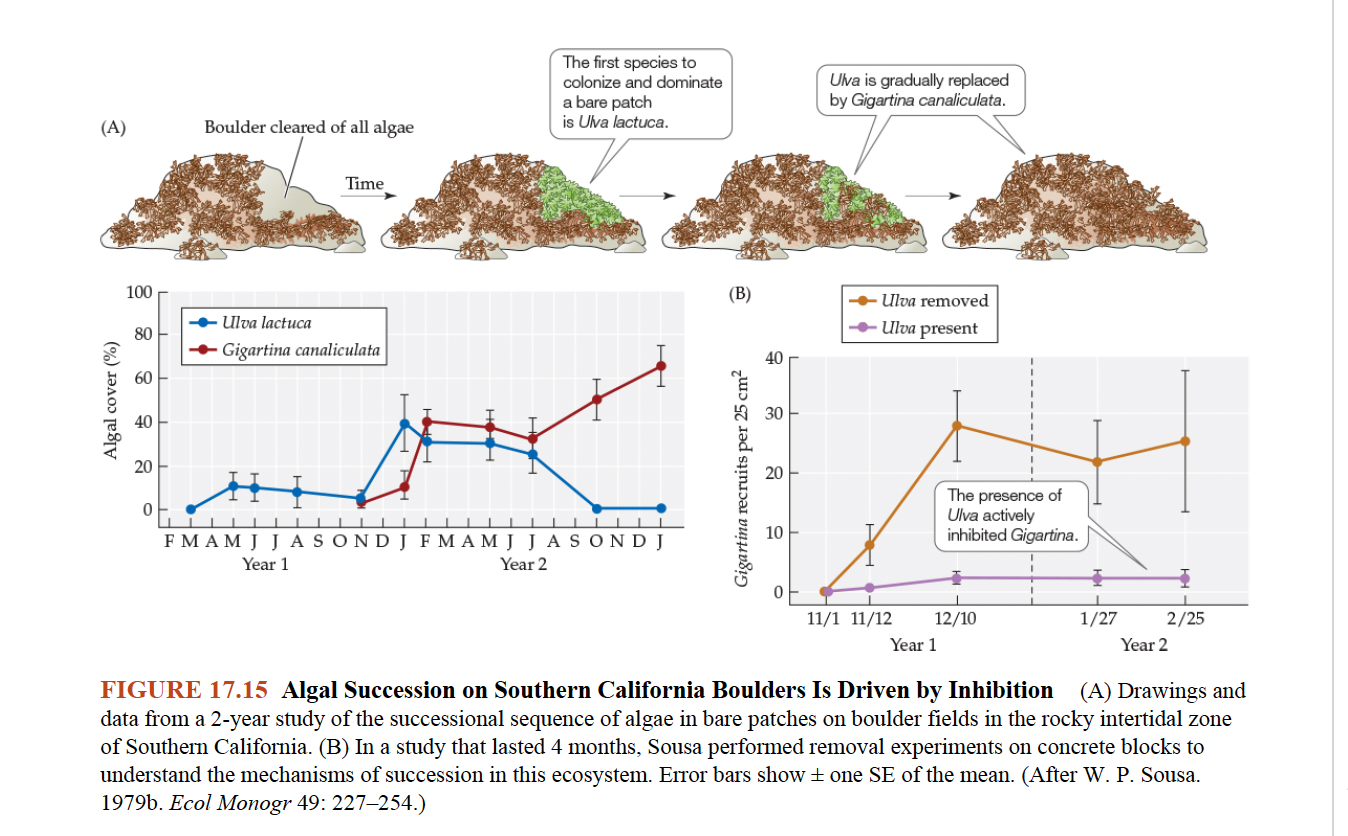
Sousa Experiment
found that the first species to colonize and dominate a patch was always the bright green alga Ulva lactuca (FIGURE 17.15A). It was followed by the red alga Gigartina canaliculata.
Found that colonization by Gigartina was accelerated if Ulva was removed (inhibition) controlling succession,
If Ulva is able to inhibit other seaweed species, why doesn’t it always dominate?
- Sousa found that grazing crabs preferentially fed on Ulva, thus initiating a transition from the early Ulva stage to other mid-successional algal species.
In turn, the mid-successional species were more susceptible to the effects of stress and parasitic algae than the late successional Gigartina.
- Gigartina dominated because it was the least susceptible to stress and consumer pressures.
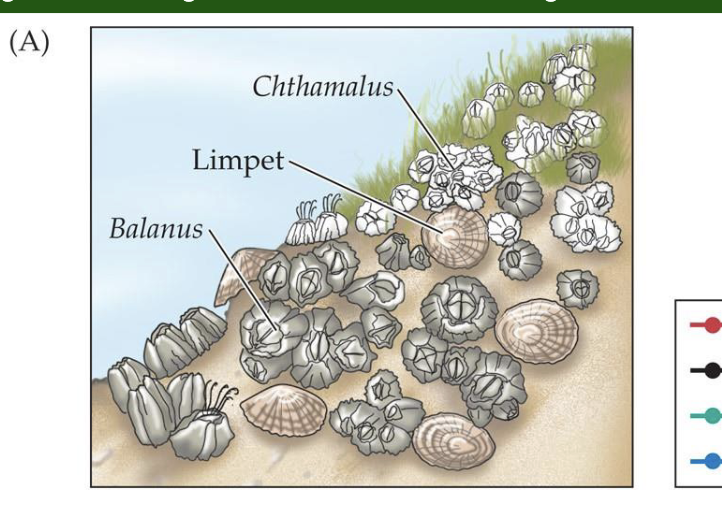
Farrell Experiment
Farrel saw that in the Oregon intertidal zone the uccessional order of these:
Cthamalus (barnacle) -> Balanus (barnalce -> macroalgae (algae)
Tolerance to facilitation
Removal experiments showed Balanus was able to outcompete Chthamalus over time
= tolerance model.
Balanus did not hinder macroalgal colonization, but facilitated it,
= facilitation model.
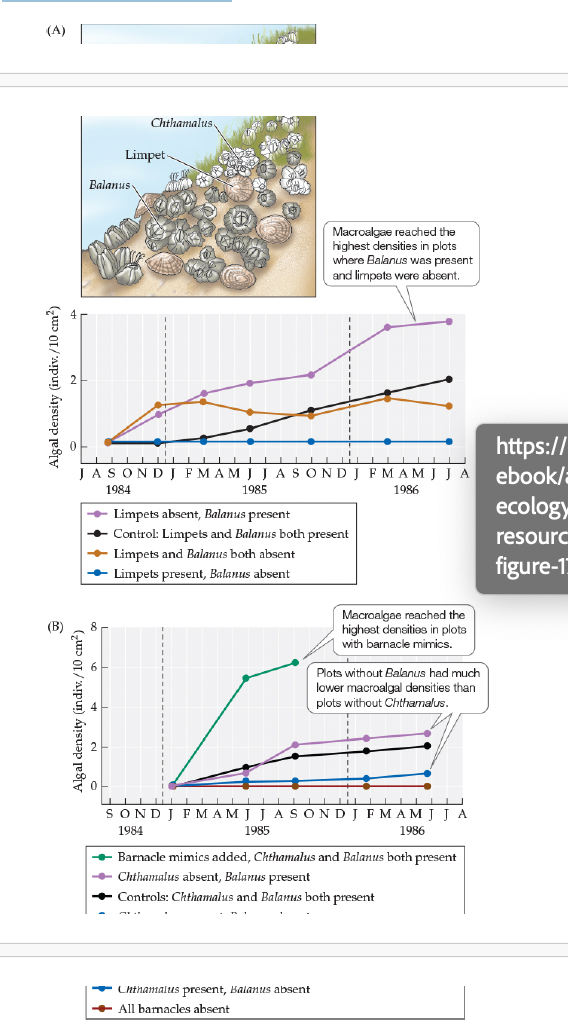
Farrell Experiment: But why and how would Balanus facilitate macroalgal colonization?
Farrell created experimental plots from which Balanus, limpets, or both were removed, then observed macroalgal colonization in those plots.
He found that macroalgae colonized all of the plots without limpets but had a much higher density in the plots with barnacles than in those without barnacles
- These results suggested that Balanus did indeed act to impede limpets from grazing on newly settled macroalgal sporelings
Farrell Experiment- Why doesn’t Chthamalus have the same facilitative effect on macroalgae that Balanus does?
Farrell suspected that the reason was Balanus’s larger size (it is nearly three times wider than Chthamalus).
It seems likely that the smaller and smoother Chthamalus does not retain as much moisture, or block as many limpets, as the larger and more sculpted Balanus—or the mimics, for that matter.
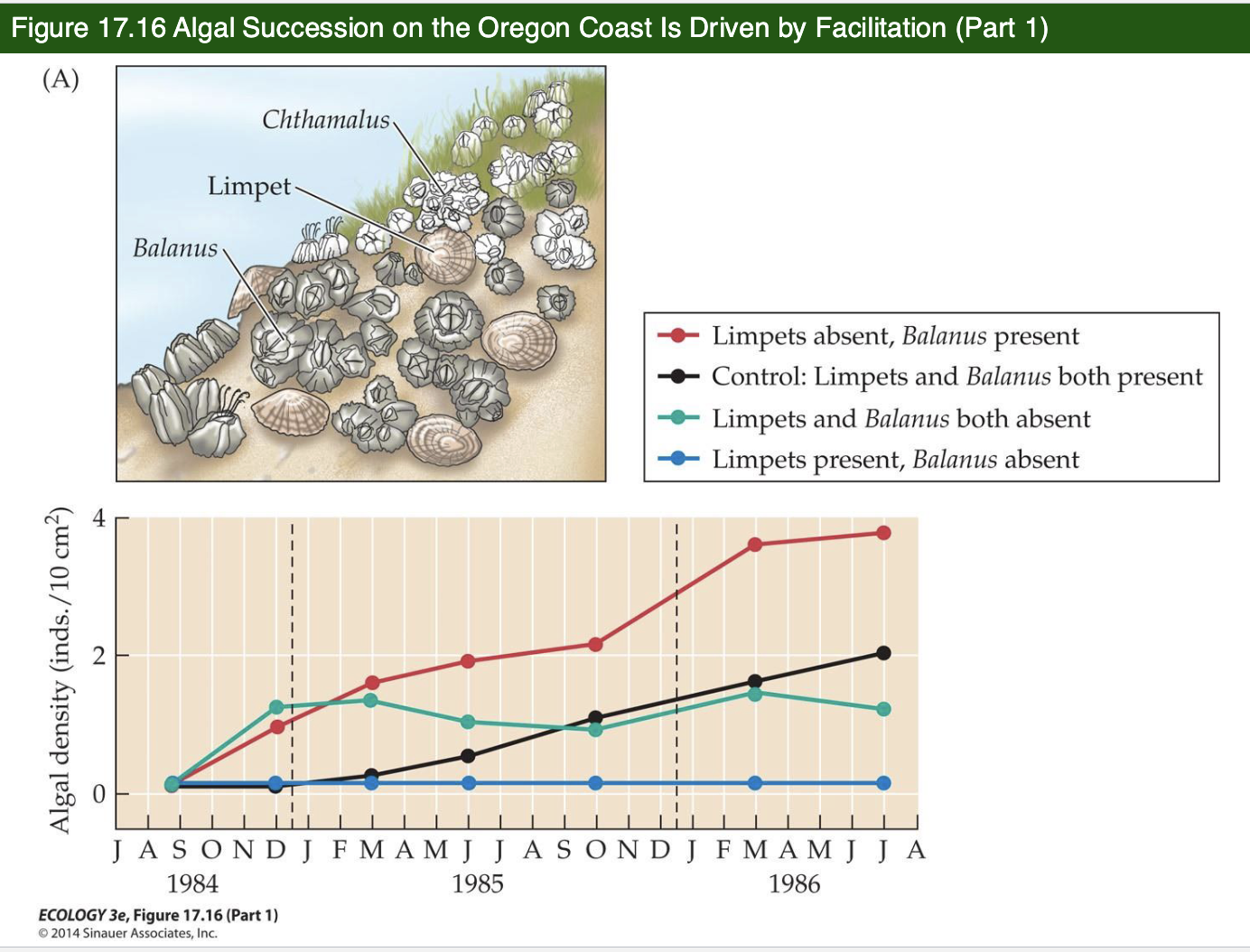
Explain Farrell Experiment Setup Figure 17.16- Algal Succession on the Oregon Coast is Driven by Facilitation
What overall conclusion can be drawn from this study?
1. Succession followed a predictable species sequence:
First colonizer: Chthamalus dalli (small barnacle)
Replaced by: Balanus glandula (larger barnacle)
Followed by: Three macroalgal species — Pelvetiopsis limitata, Fucus gardneri, Endocladia muricata
2. Tolerance model supported:
Chthamalus did not inhibit colonization by Balanus
Instead, Balanus outcompeted Chthamalus over time
→ Supports the tolerance model, where later species are not prevented by early ones, but outlast them due to competitive superiority
3. Facilitation model supported:
Balanus facilitated macroalgal colonization
Macroalgae colonized better in the presence of Balanus, especially when limpets (grazing snails) were removed
→ Suggests Balanus protected algae by:
Reducing desiccation stress
Physically blocking limpets from grazing new algal sporelings
4. Size matters — Balanus vs. Chthamalus:
Balanus is ~3x larger than Chthamalus
Larger barnacle mimics (made of plaster) had an even greater facilitative effect on macroalgal growth than real barnacles
→ Conclusion: Size and structure influence how well a species can buffer environmental stress and prevent consumer access
🔁 Key Takeaway:
Farrell’s work revealed that facilitation and tolerance play important roles even in competitive, space-limited systems like the rocky intertidal zone. Succession is not governed by inhibition alone, but by a dynamic interplay of biotic interactions shaped by species traits (like size) and environmental stress.
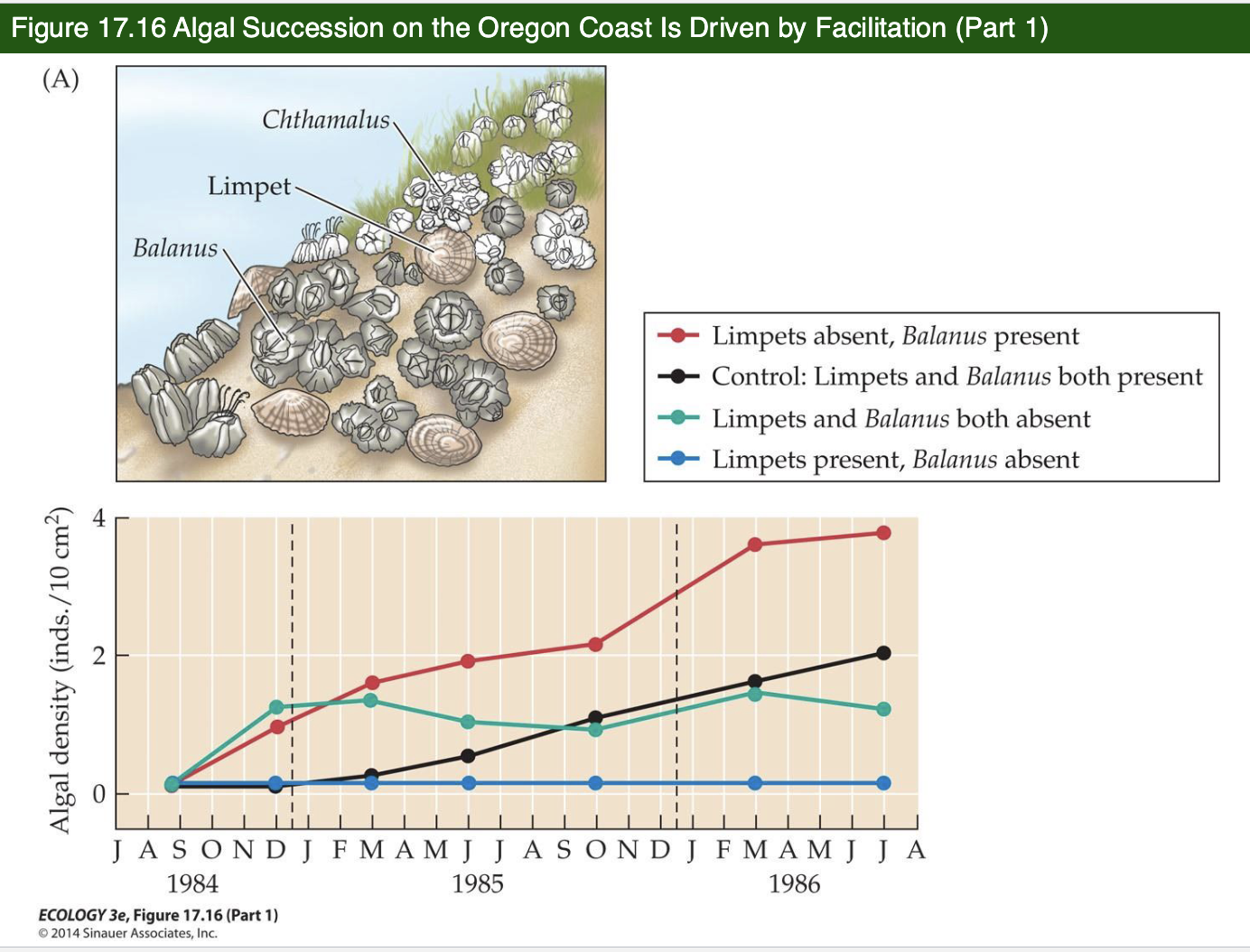
Succession summary
Driven by many mechanisms - no one model fits any one community.
Facilitative interactions are often important drivers of early succession, especially when physical conditions are stressful.
As succession progresses, larger, slow growing and long-lived species may begin to dominate.
Competition may play a more dominant role later in succession.
Facilitative interactions are often…
Important drivers of early succession, especially when physical conditions are stressful.
As succession progresses…
larger, slow growing and long-lived species may begin to dominate.
Alternative stable states
Different communities develop in the same area under similar environmental conditions
Competition may play a more…
dominant role later in succession
Stable Community
When the community returns to its original state after perturbation.
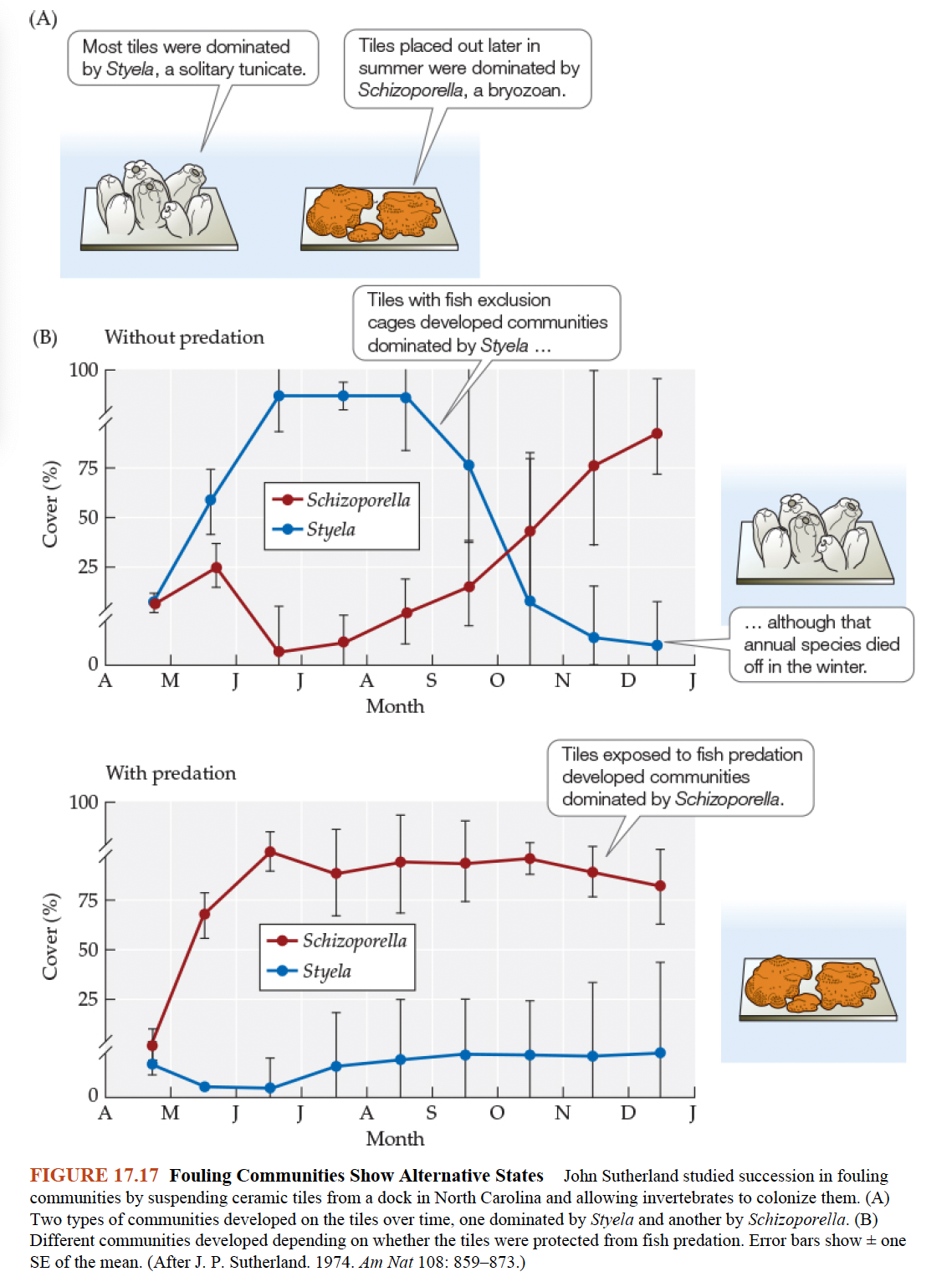
Sutherland (1974) study on Marine Fouling Communities Experimental set up
Investigated succession and community stability in marine fouling communities—organisms like sponges, hydroids, and tunicates that colonize hard surfaces like docks and ship hulls.
Setup:
Ceramic tiles were suspended from a dock
Placed out in spring to allow natural colonization by invertebrate larvae.
Observation:
Over 2 years, the tiles developed two distinct communities:
Dominated by Styela (a solitary tunicate)
Dominated by Schizoporella (a bryozoan)
Key Observations:
Styela tiles stayed stable—other species couldn’t invade once Styela had established.
Schizoporella formed its own stable community when tiles were placed in late summer.
Styela declined in winter but recolonized strongly each spring.
Fish Exclusion Experiment:
New tiles were set out with half enclosed in cages to exclude fish predators.
Caged (no predators): Dominated by Styela
Uncaged (predators present): Dominated by Schizoporella
Ecological concepts of Sutherland’s study outcomes
Styela is competitively dominant if left undisturbed (no predators).
Schizoporella dominates in the presence of predators that prevent Styela from establishing.
Once Styela gets large enough, it acts as its own “cage,” protecting itself from predators (natural defense via size).
Suggests strong species interactions (especially with predators) determine which community forms.
Alternative Stable States
Sutherland’s work supports the theory that multiple stable community types (states) can exist under the same environmental conditions, depending on species interactions and history.
Styela-dominated and Schizoporella-dominated communities are seen as two “valleys” in a stability landscape (see Figure 17.18).
A “ball” (the community) may settle into one valley or the other depending on key factors like predator presence.
If a strong interactor is removed or added, the system may shift states and not return—this is called hysteresis.
What factor influenced which species became dominant in the communities in Sutherland’s study?
The timing of tile placement—tiles placed in late summer favored Schizoporella dominance.
What is the main ecological lesson from Sutherland’s study?
Small differences in initial conditions (like timing) can lead to different long-term stable community structures.
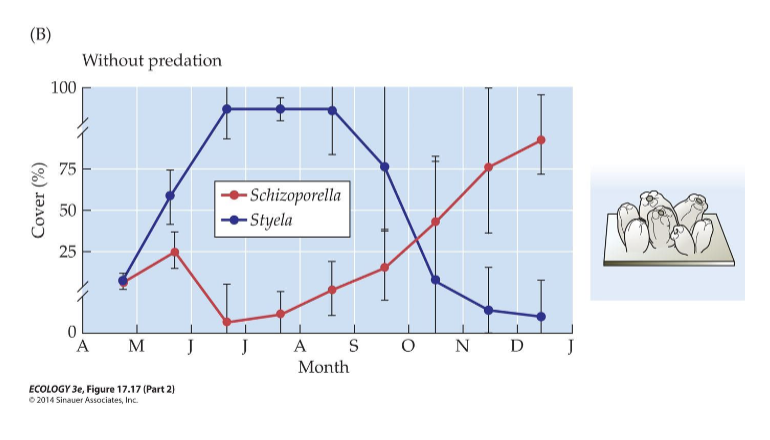
What do the graphs in Figure 17.17 illustrate?
They show how predation affects the dominance of Styela (tunicate) vs. Schizoporella (bryozoan) in marine fouling communities.
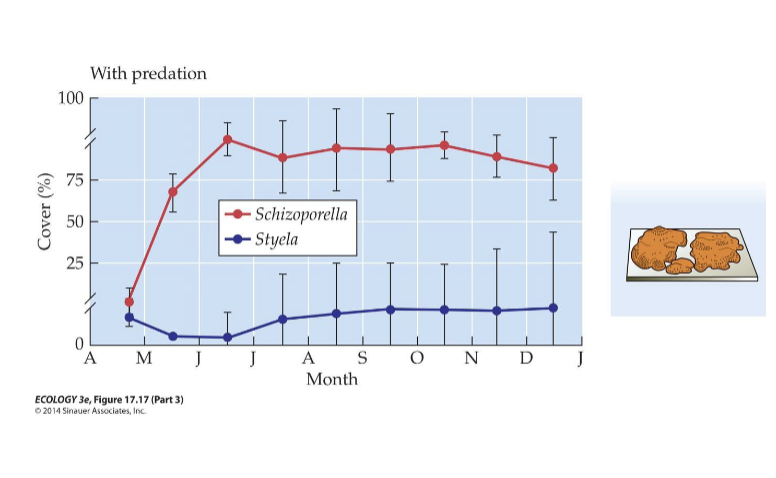
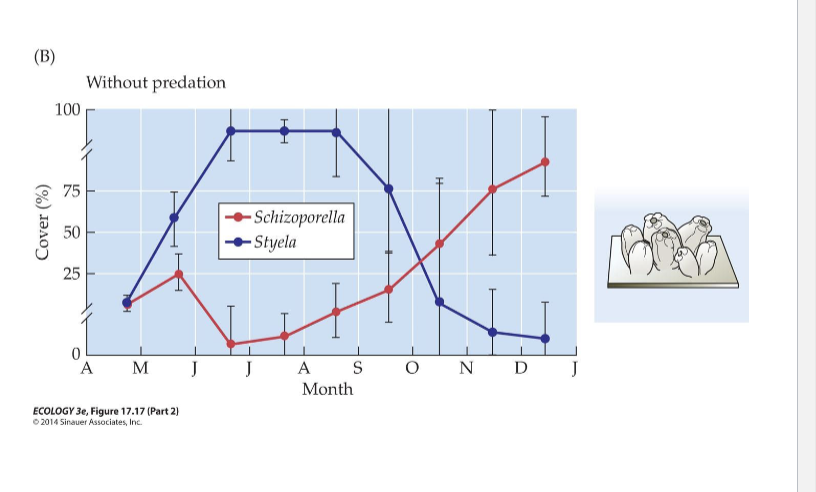
In the absence of predation, which species dominated during summer months?
Styela dominated from June to September.
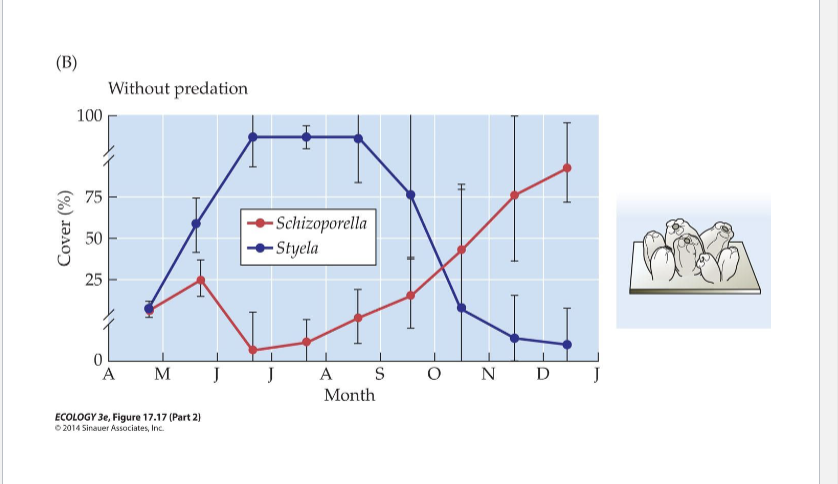
What happened to Schizoporella when Styela was dominant (without predation)?
A: Schizoporella had very low cover and only increased again as Styela declined (starting October).
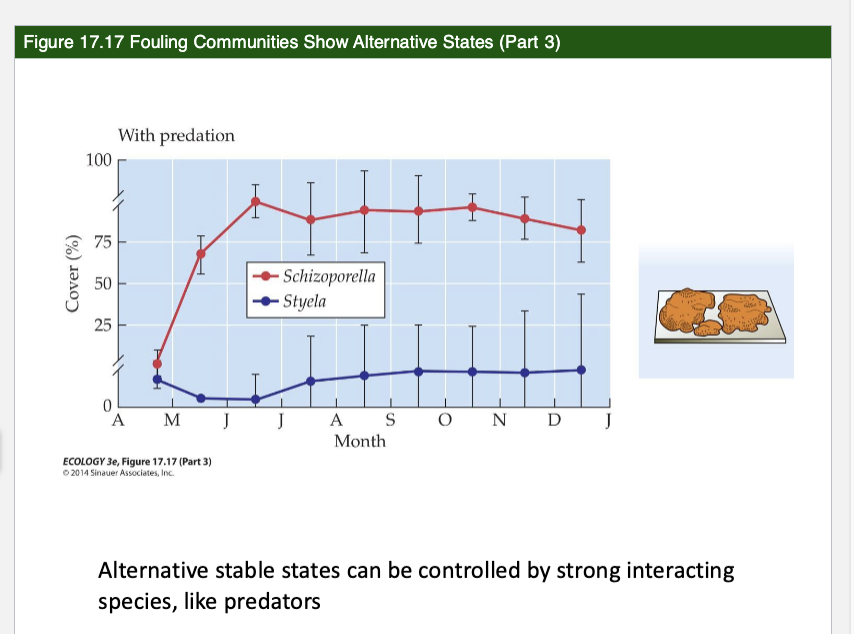
How did predation affect community composition?
A: Predators suppressed Styela, allowing Schizoporella to dominate consistently throughout the year.
Q: What do these results say about the role of predators in maintaining community structure?
A: Predation prevented Styela from dominating, stabilizing a community dominated by Schizoporella.
Two different stable communities seemed to result:
One dominated by Styela, a solitary tunicate.
One dominated by Schizoporella, a bryozoan, on tiles placed out in late summer.
Q: What does this experiment demonstrate about alternative stable states?
A: Predation can shift communities between alternative stable states—one with Styela dominance (without predators), the other with Schizoporella dominance (with predators).
Alternative stable states can be controlled…
by strong interacting species, like predators
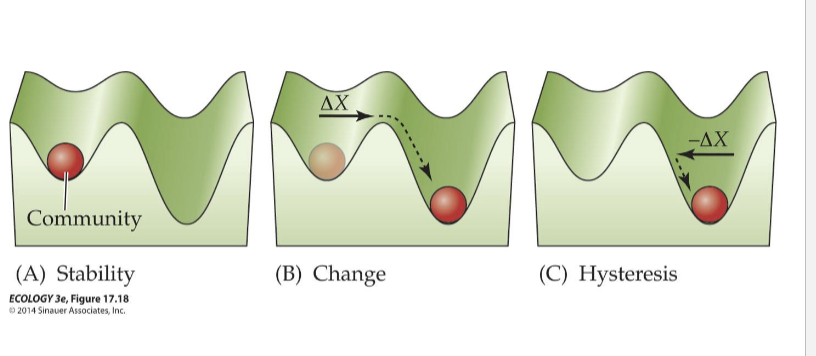
Hysteresis
Is an inability to shift back to the original community type, even when original conditions are restored.
Cultivation
Depensation hypothesis: adult cod may eat competitors for juvenile cod
Decreases in river herring (a proposed food source) resulting from damns is preventing cod recovery
Ocean warming could be limiting the recovery of cod